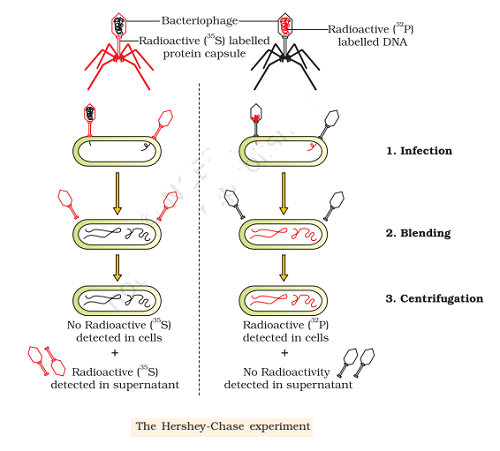Hershey-Chase Experiment:
In 1952, Alfred D. Hershey and Martha Chase performed a confirmatory experiment using T2 bacteriophage to prove DNA as genetic material. Bacteriophage T2 is a tailed virus of Escherichia coli.
Viruses are the simplest living organisms and their reproduction is totally dependent on the metabolic machinery of the host. The viruses infect the bacteria and are called as bacteriophage. Bacteriophage T2 which infects the bacteria is composed of about 50% protein coat and 50% with an inner core of DNA. The bacteriophage T2 attaches the host bacterium by means of a tail. It enters its DNA into the cytoplasm of bacteria and the protein coat remains outside the cell. After half an hour, the bacteria cell bursts and numerous phages come out of the bacterial cell. This is due to fact that phage DNA lyses the bacterial cell and uses its metabolic machinery for synthesizing more of their DNA copies and protein coats. Thus, the parental DNA of the virus carries the genetic information which directs the synthesis of both DNA molecules and the protein coats of the progeny.
Hershey and Chase allowed to grow both bacteriophage T2 and E. coli cells in a medium supplemented with radioactive isotopic phosphorous P32 or radioactive sulfur S35. E. coli growing on a medium containing either P32 or S35 were infected by the T2 phage. Then radio-labelled T2 phages were recovered from the respective culture medium by centrifugation. The progeny phages contained S35 protein and P32 labelled DNA. Both types of phages were allowed to infect E. coli cells separately growing on a fresh normal medium. After some times (20 minutes) when infection was over, the empty phage coat proteins were recovered from the infected bacterial cells by agitation using a kitchen blender. The phage coat proteins were separated from infected cells by low speed centrifugation. The phage particles are present in supernatant and bacterial cells settled as pellets. Radioactivity in these two fractions was measured in both sets of an experiment.
It was found that the bacterial cells showed radioactivity when P32 labelled phage infected E. coli cells. When S35 labelled phage was used to infect E. coli, the empty phage showed radioactivity but not the bacterial cells. The progeny phage also contained P32 in DNA but not S35 in coat protein.
Hershey and Chase concluded that T2 phage delivered its DNA into bacterial cell leaving the coat protein outside the cell wall. Progeny phage particles were produced inside the cell and consisted of P32 in their DNA and unlabelled protein coat. It showed that DNA acts as genetic material. That is why it synthesises a new protein coat and replicates DNA.










Comments (No)